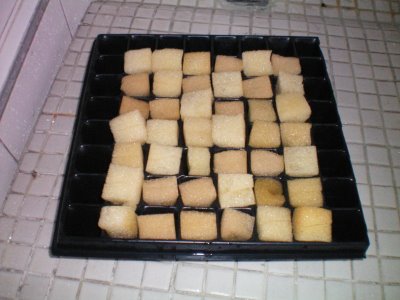Once your cube is cut and ready, you have to presoak it in water. Simply squeeze the cube under water and let it absorb all the liquid it can. Once you take it outside, do not squeeze it again since this will make the cube exchange the water it just absorbed for air.
Now simply deposit each seed inside a cube and place the cube in a tray for seed germination someplace where the appropriate conditions for the germination of your seeds are present. You can keep the seeds and the surface of the foam wet by misting water over the cubes everyday. Once the seeds germinate you can place them in your favorite hydroponic setup and the roots will grow out of the foam cube, into any solid media or nutrient solution. (below, an image of my germination setup ready for seed placing).





